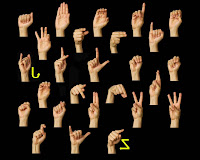American Sign Language
Hello, lovely Pie readers! Surprise! You get another week with me, Miranda! Alicia is off vacationing in the "Real World House," so I volunteered to take up the duties over here on the blog. Hope you all don't mind. So without further ado--
Another small fun fact about me is that, while in college, I actually minored in American Sign Language. There was no real reason for this. I had already met the language requirement for my school by taking seven years of French from ages 9 to 16. So, I didn't even need to take ASL. I just really wanted to learn a new language. After the first semester, I loved it and wanted to learn more, so I continued and was able to make it my minor.
Some of you may be familiar with ASL, maybe you know a person in the deaf community. But it's also likely that many of you may have no experience with the language and culture beyond learning how to finger spell many years ago in grade school. I'd like to give you some interesting facts about the language and maybe inspire some to go out and learn more!
One common misconception is that American Sign Language is just signed English. It is definitely not! ASL is its own separate language with its own set of rules and grammar. And just like any language, it can be complicated and takes many many years to truly learn and become completely fluent. An easy and singular example of how ASL is very different from spoken English is this-- while Americans and those from the UK share a common language (English), American Sign Language is completely different from British Sign Language and do not resemble each other at all. Also unlike English, ASL does not use tense or articles as we are used to speaking (for example, there is no sign for 'the,' as that word doesn't really exist in ASL). And just like there are different accents around the United States, there are different dialects of ASL. The sign for Starbucks on the East coast is not the same as the sign for it on the West coast.
Not all ASL signs are "transparent" signs. In fact, most are not transparent at all. A transparent sign is one in which the meaning can easily be guessed by a non-signer. A great example is the sign for throwing up. If I were to show it to you without telling you what I was signing, you'd probably figure it out right away. A translucent sign is one in which the meaning is easily understood and remembered once it is explained. An example of that may be the sign for arguing. If you saw it, you wouldn't be able to intuitively know what it was. But once you learned, it would make sense. Most ASL signs are opaque and have no obvious relation to the action performed in the sign itself. As a non-signer, you would be completely lost.
The culture of the deaf community is very different from the hearing community. ASL is a much more blunt language and mentality. Hearing people tend to be discreet, stay away from "taboo" subjects, etc. But in the deaf community, the more knowledge, the better. Often when two deaf people meet for the first time, it's not uncommon to ask about everything-- what school did you go to? How many people are in your family? What type of home you live in, etc. It's a very information sharing community. A great example is in a hearing school, if a student is late, they probably try to sneak into class as quietly as possible so as not to be noticed or disrupt what is going on. In a deaf class, that would never happen. It would be expected for you to fully explain why you're late, what happened, are you alright, etc.
There is so much more that I couldn't possibly describe in a blog! Most importantly, I can't teach you the signs. My best advice if you're interested in learning is to check out some YouTube videos to learn simple signs, or check out some video podcasts. If you're really serious, enroll in a course! But make sure the professor is deaf. Best way to learn is by full immersion!
What other languages and cultures do you guys know?

